In pictures: Farm Inventions 2016 complex category
An overwhelming response to entries for this year’s Farm Inventions Competition proves that ingenuity on farms is still very much alive and kicking, despite all the clever technology that is now available to farmers.
We take a closer look at the biggest and most sophisticated entries, which make up the complex category. These inventions will make use of an engine or complicated combination of electrics and hydraulics.
Read about the inventions in detail, see the photos and there’s a couple of videos too.
Winner: Mark Waggett’s pivot-steer loader
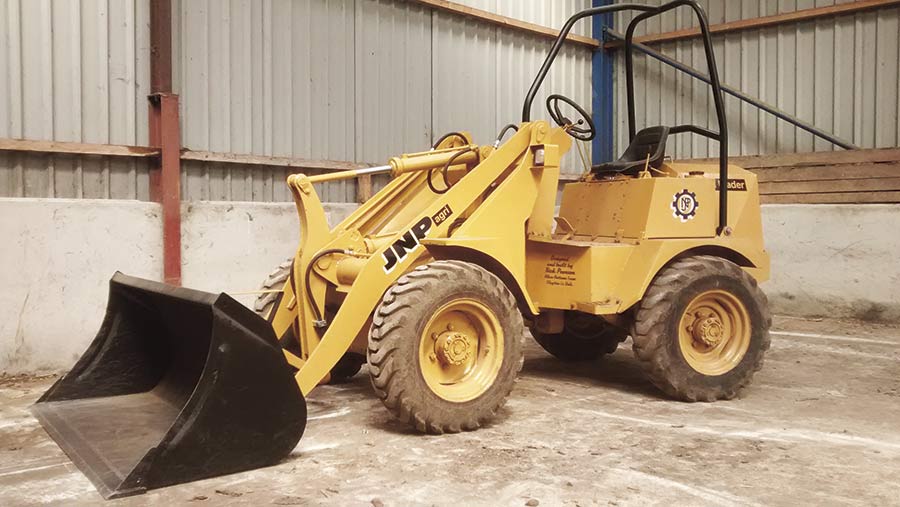
Mark Waggett has been running his homemade loading shovel at the family’s 63ha beef and sheep farm for the last 20 years.
It was his late brother Nick Pearson who did the majority of the work, pottering around in the odd hours he had spare from running his own ag engineering business.
At its heart is a Perkins P3 engine, which was positioned carefully above the rear axle to provide a decent counterweight for the front end.
The 48hp, 2.5-litre block drives through a JCB 3C torque convertor and via a forward/reverse unit to a homemade gearbox.
Mr Pearson had decided he needed two forward and two reverse speeds to get around the yard. Once he had calculated the ratios, he sourced cogs from the boxes of a couple of old International and Lelyland tractors.
After laying them out on the bench, he cut the shape of a gearbox from heavy plate steel before sending it to be heat treated and toughened.
A local engineer bored the shaft centres before homemade selectors were fitted to finish the job.
A piston pump pinched from an old John Deere is driven off the crankshaft to provide enough hydraulic power to carry two 600kg fertiliser bags, an auxiliary service and an oil supply to the double-acting pickup hitch.
Runner-up: Tom Carrigan’s round bale chaser
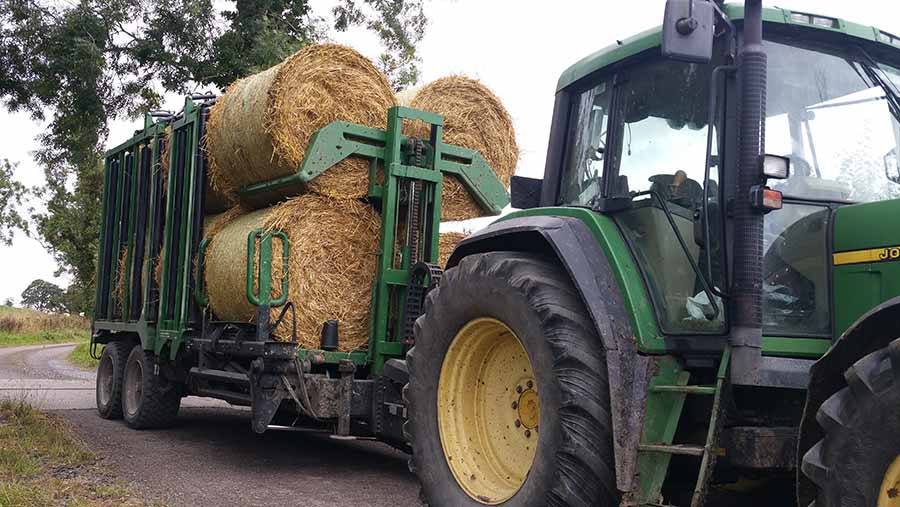
Dairy farmer Tom Carrigan from Kilkenny, Ireland, has spent four years planning and building a prototype round bale chaser.
His first effort was a five-bale collector, but after selling that to a local contractor he embarked on a more complicated design.
The 6t collector can carry a total of 16 bales in a two-wide, two-high, four-long configuration, with telescopic sides allowing in/out adjustment to suit varying bale sizes.
The idea was to trim the number of men and machines involved in the collection process, while also getting the bales back to base soon after wrapping to minimise crow damage.
At the front of the chaser is a swing-out squeezer arm that picks up each bale individually and lifts it onto the roller deck. Once four bales are stacked, the group is pushed back ready for the next row to be loaded.
Mr Carrigan claims he can collect a 16-bale load in 15 minutes and unload the lot in just 7 minutes. Bales are dropped off in groups of eight, with the back half of the trailer splitting from the front to sit the bales on their flat side.
Control is via a box in the cab of Mr Carrigan’s John Deere 6910, but the combination of buttons and joysticks currently makes the job a bit cumbersome and he plans to automate things next year.
See the bale chaser in action in this video.
Highly commended: Richard Sadler’s 24m weed wiper
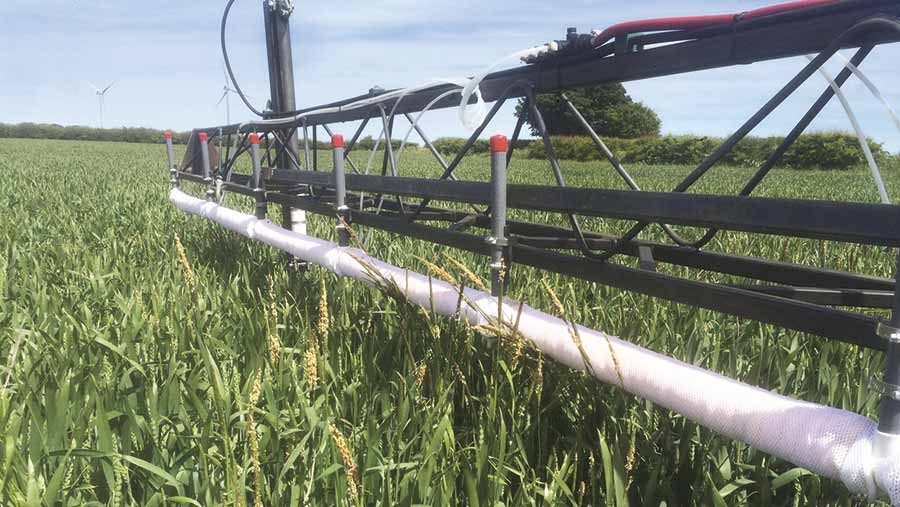
After dabbling with crop rotations and spring sowing, Richard Sadler decided to wage war on blackgrass from the farm workshop by building a 24m trailed weed wiper.
The rig has now been used across a good chunk of his 275ha of wheat ground in East Yorkshire to try to clear the resistant blackgrass that plagues the heavier land.
Small weed wipers tend to be more at home dealing with thistles in paddocks, but Mr Sadler decided he could take the working width out to 24m without risking wiping out acres of precious wheat.
Mounting it on a sprayer was out of the question because of the limited height adjustments, so instead he welded together a five-section frame.
The position of each section can be controlled hydraulically from the cab, with pivoting wheels in between to make sure it follows the contours of the ground.
For the running gear, Mr Sadler modified space saver car wheels and combined them with homemade hubs before fitting a crop divider in front of each one to neatly part the wheat plants and save flattening swathes of land.
Glyphosate is stored in two 110-litre sprayer tanks, which keeps the drip-free sponge bar saturated.
Travel speed is a steady 5kph – making it possible to cover 40ha/day – with the operator adjusting the working height of each section on the move. It also guarantees each blackgrass plant gets a good wipe of weed killer.
To improve the efficacy further, Mr Sadler runs across the field in both directions to make sure that no plants are missed and he claims control levels can reach up to 90% in good conditions.
Harry Birnie’s bale trailer
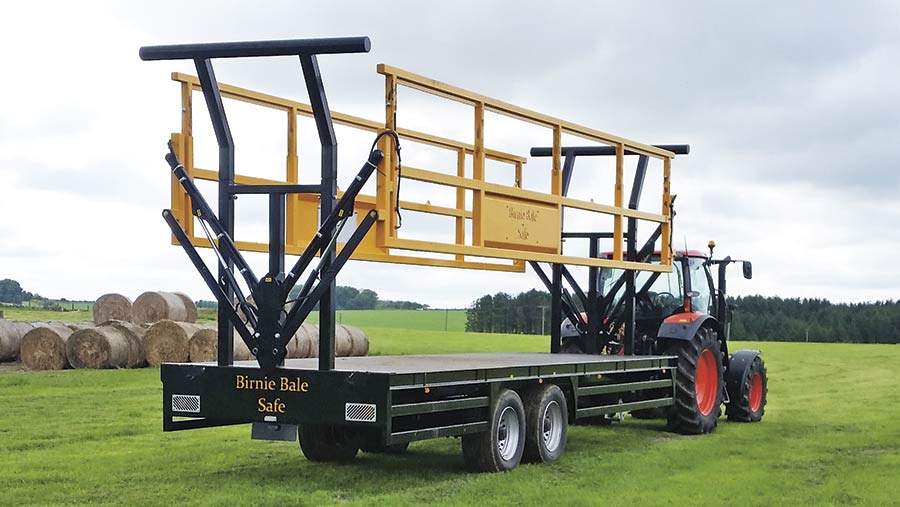
Livestock farmer Harry Birnie and his sons Stephen and Iain from Maud, Peterhead, designed a trailer to safely haul straw bales back to the farm.
After years spent sketching out potential plans, they headed to the Highland Show in search of a trailer that would fit the bill. However, none of the established companies offered anything similar to the hauler they were after.
So instead, the family signed up a local welding firm to do the manufacturing of their Bale Safe trailer.
Starting with a blank canvas meant splashing out on a new heavy-duty chassis and two axles with hydraulic and air-activated anchors, while super-single rubber was chosen as the most suitable footwear.
On top, they sat a 2.5m wide, 8.5m long chequerplate deck that can carry 34 round bales stacked three high.
Securing the load is done by a big frame on each side that straddles all three rows of bales. The steel sides are locked in place when there’s no pressure supplied by the tractor’s spools, which means there’s no danger of the bales tumbling off even if a pipe bursts.
In all, the total build cost was around £13,000.
Geoff Eyre’s wrapping station
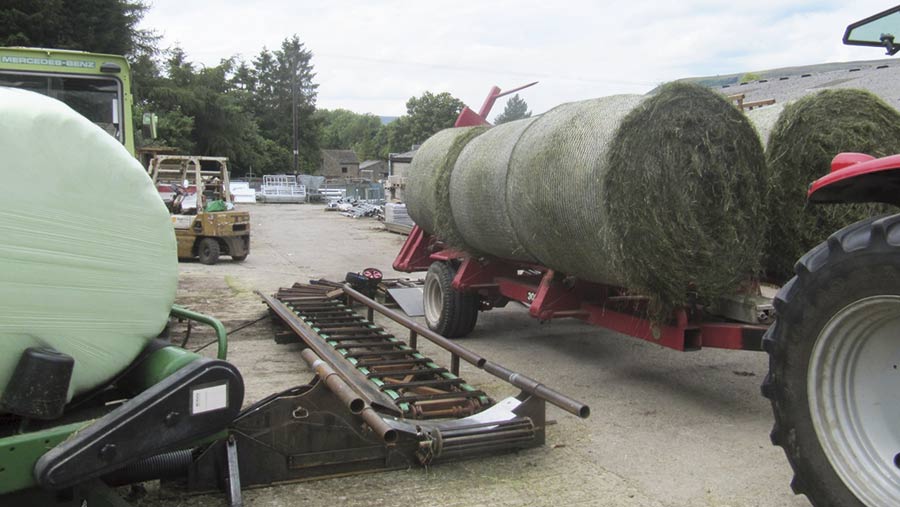
Farmer-cum-inventor Geoff Eyre, who runs 500ha of upland ground in the Peak District, first won the Farmers Weekly Inventions Competition back in 2000 with his novel non-stop round baler.
Winding back the clock even further, he built a self-loading round and square bale transporter in 1983 that did away with the need for a telehandler, before handing the manufacturing rights over to Ritchie.
This time around, he has developed a yard-based bale wrapping system to work with his Traileyre as an alternative to an in-field combi baler wrapper.
Once collected – baled, but not wrapped – the crop is brought to the yard and dropped onto a conveyor system that runs either side of the trailer.
The rollers are powered by a series of five hydraulic motors via a 15:1 gear reduction that takes the bales to a lifting ram and eventually onto a McHale yard wrapper.
According to Mr Eyre’s calculations, the Traileyre can shift bales a one-mile jaunt from the field to the yard at a rate of 40/hour, so his system needs to be quick to avoid a wrapping backlog.
At full whack, he claims the wrapper can throw a bale off the production line every 35 seconds.
The advantage of his set-up, he says, is that the bales need just four layers of wrap because they’re at less risk of being punctured by loader grabs or field stubble.
The wrapping station can be moved from job to job by folding the conveyors upright on both sides before attaching a clamping bracket.
Next Mr Eyre plans to make the roller system radio controlled to make sure that it keeps up with the trailer.
See the wrapping station in action in this video.
Paul Evans’ grader
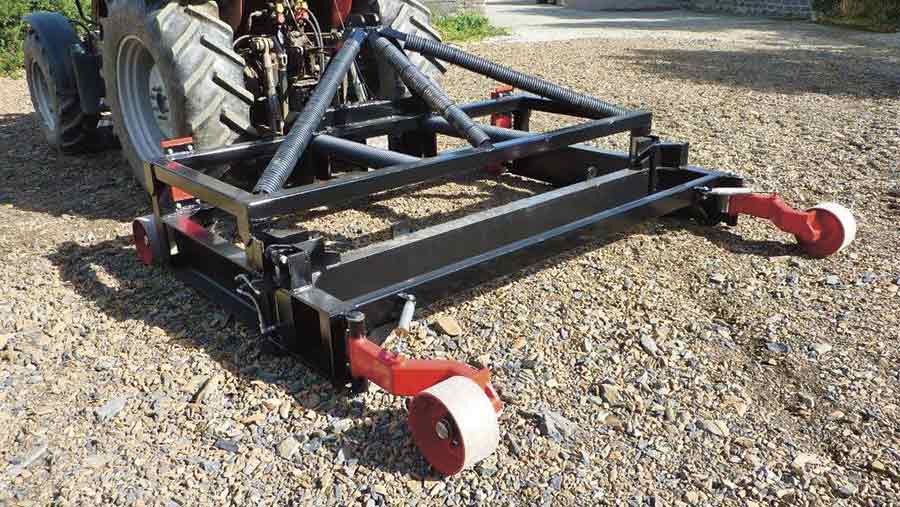
Paul Evans of West Denant Farm, Haverfordwest, built his own farm track grading machine with the help of his two sons.
It can be used to rip up and relevel existing surfaces, or be dragged along as a box grader to spread a layer of ballast evenly across its working width to form a new surface or fill potholes.
To lay and grade new material the 25mm thick, super-hard bucket-lip blade is fitted facing forwards to slice through the ballast.
For smoothing off the tracks the centrally mounted blade is lifted out via specially designed lugs and turned to face rearwards.
The height of the blade assembly is adjusted by two hydraulic cylinders, which can be moved independently to create a cambered surface, or as a pair to form a flat road.
The machine works off a single spool, so the driver has to switch between the different modes by an in-cab control box.
Where possible, the hydraulic hoses are routed through the machine’s steel frame to keep them out of harm’s way.
To minimise the power required to pull the fully ballasted grader, it is kitted out with purpose-built steel wheels fitted to 6t stub axles.
The rear pair are mounted on swing arms with spring-loaded centralising stabilisers allowing it to turn without making a mess. A long wheelbase, along with floating lower links, also helps form a flat surface and means any tractor movements don’t directly affect the position of the grader.
The total build cost covered new hydraulic valves, hoses and cylinders, an electrical box, switches and wires, two stub axles and four springs, and a high-quality bucket wear strip. All of the other parts were built from scratch.
Keith Foubister’s combine tracks
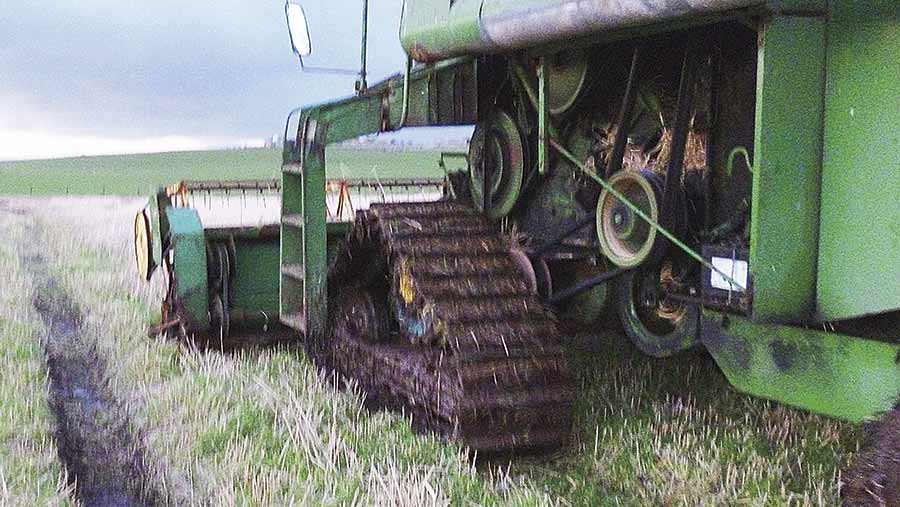
Tracked combines might be all the rage these days, but Keith Foubister first fabricated a conversion kit for his John Deere 975 harvester back in 1992.
When he was working as a contractor in the Orkney Islands, a series of wet summers almost left dual-wheeled combines redundant and forced him to find a method of treading more lightly across the fields.
The system was designed so that the tracks could be removed and wheels fitted in a couple of hours during sunnier summers. It’s based around a large sprocket taken from an old tracklayer that fits in place of the original wheel, but reduces ground speed by about half in the process.
An old tracked digger provided the two idler wheels on each side, while the rubber tracks were sourced from an ex-forestry machine – the deep lugs providing brilliant traction over the sticky ground.
He also found the track system was much easier on his combine’s transmission than many of his neighbours’ machines. While they battled their way through thick, cloggy mud, he scooted along the surface with little resistance.
Mr Foubister’s first conversion had trouble with the knife drive catching on the tips of the tracks when cutting short stubbles, so he subsequently lengthened the intake trunk of the combine by 17in to get extra clearance.
Though he has newer combines, the old 975 remains fitted with the tracks and came out to do a few acres just last year.
James Tarry’s subsoiler toolbar
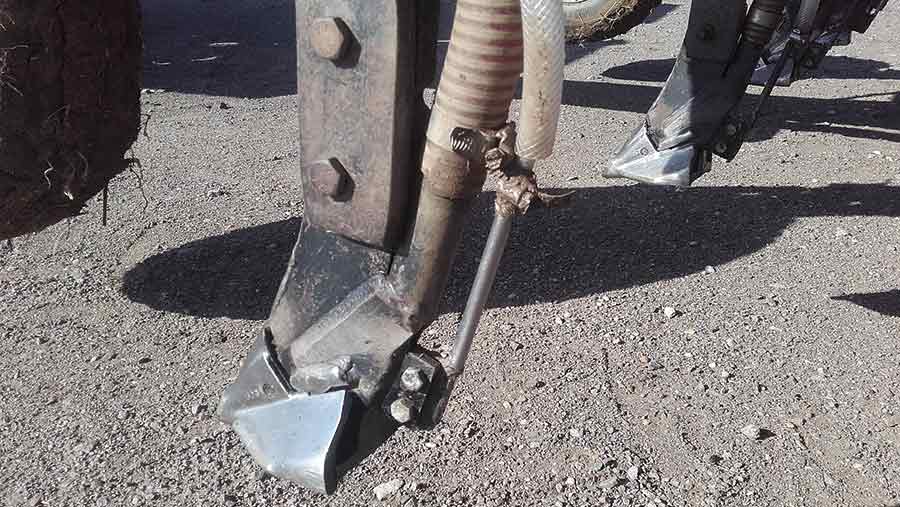
James Tarry fabricated his subsoiler toolbar in a bid to improve oilseed rape establishment across his Kettering farm.
The system is based around a Gregoire Besson Heliplow subsoiler frame, with the cranked legs adapted to carry JJ Metcalfe’s low-disturbance feet.
However, to extend its use to crops other than OSR, Mr Tarry designed a floating-arm linkage on the subsoiler that would allow it to tow his Horsch CO4 tine drill. The small foot minimises soil heave to leave an even surface for the drill, and folding frame extensions were fitted so the subsoiler could match its 4m working width.
The subsoiler set-up cost £1,000 in metal, while the fertiliser kit on top cost another £1,500.
It consists of two liquid fert tanks, a pump and flow controls mounted on the subsoiler frame. Fertiliser applicator spouts were then mounted on each coulter to provide starter fertiliser alongside each seed row.
At the back, the drill’s Horsch Duet coulters were replaced with universal coulters from Dutch Openers to allow for direct drilling. A Stocks Turbo Jet is also carried behind the drill for applying Avadex or slug pellets.
The depth of the subsoiler can be altered independently of the drill because the latter runs on its own wheels.
For drilling cereals, the subsoiler can be separated from the drill and used earlier in the season to loosen soil and encourage weed germination before going in with the CO4 later in the season when the ground is wetter and subsoiling is less effective.
Ed Coombes’ cubicle cleaner
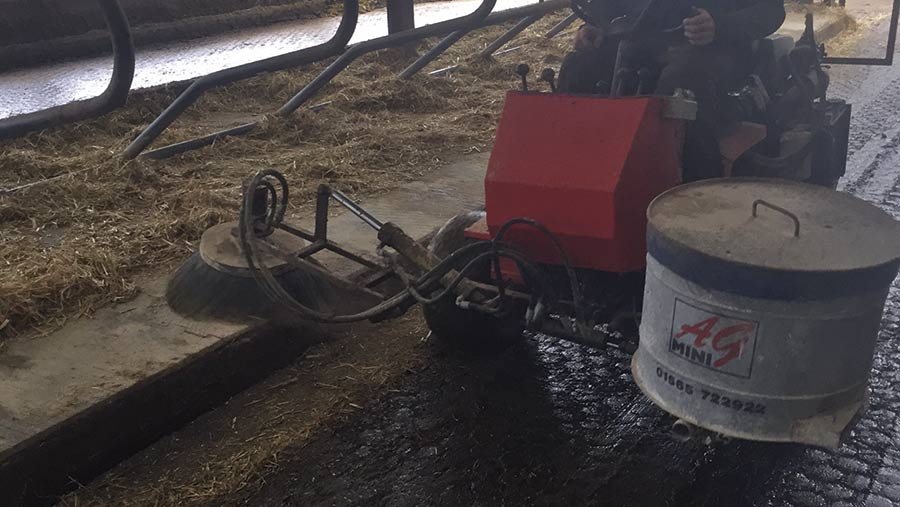
Somerset dairy farmer Ed Coombes adapted an old three-wheeled greens lawnmower to help bed his 260-head dairy herd.
It is powered by a three-cylinder Kubota diesel engine, which Mr Coombes bought without its cutting decks on eBay for £287.
He then visited his local ag dealership to pick up a Suton cubicle brush and mounted it with a ram so that it can be lifted out of the way. On the other side, he fitted an AG mini lime spreader that runs off the mower’s battery.
The hydrostatic drive mower has three separate spools – the first is linked up to the brush, the second powers the ram that moves the brush up and down, and the third will eventually be used to move a scraper fitted underneath.
Mr Coombes reckons the two-pass job saves an hour-and-a-half’s work every day, and it produces a clean, consistent finish every time.

